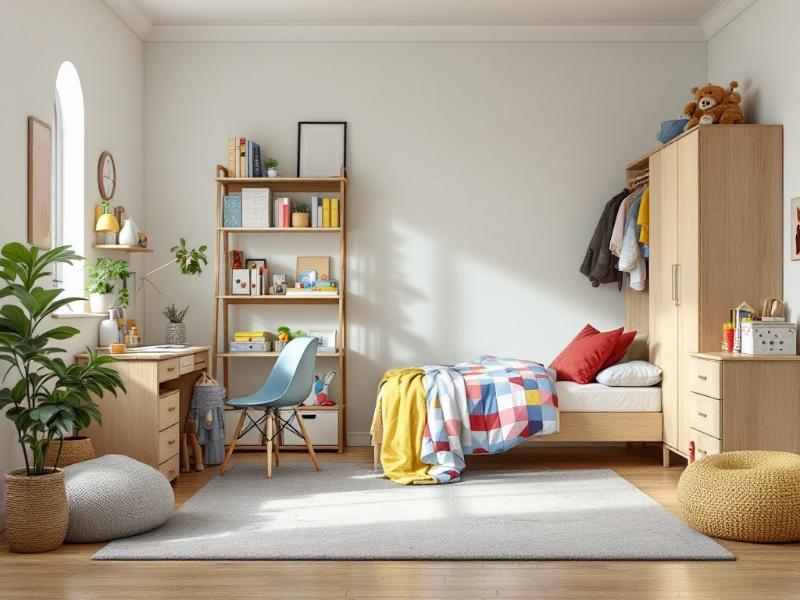Essential Pieces of Furniture Kids Need for Their Room

Designing a child’s bedroom requires careful consideration of essential furniture pieces that support growth, comfort, and functionality. A well-planned kids’ room should include a bed, storage solutions, and a study area to accommodate various activities and needs. These key elements form the foundation for a space that fosters healthy development and promotes a structured daily routine.
When selecting functional bedroom furniture for kids, it’s important to prioritise versatility and durability. A comfortable bed serves as the centrepiece, while wardrobes and dressers provide ample storage for clothing and personal items. Adding a desk and chair creates a dedicated area for homework and creative pursuits, encouraging focus and organisation.
Key Takeaways
- Essential kids’ room furniture includes a bed, storage units, and a study area.
- Versatile and durable pieces support a child’s changing needs as they grow.
- Well-chosen furniture contributes to a functional space that promotes healthy habits and routines.
Essentials for Rest and Comfort
A child’s bedroom should provide a cosy sanctuary for sleep, relaxation, and quiet activities. The right furniture and accessories create a comfortable environment that promotes rest and well-being.
The Perfect Bed
Selecting an appropriate bed is crucial for a child’s comfort and growth. A twin-size bed suits most children, offering ample space without overwhelming the room. For siblings sharing a space, bunk beds maximise floor area while adding a fun element.
Choose a bed frame with rounded edges to prevent injuries. Solid wood frames provide durability and timeless appeal. Some bed designs incorporate storage drawers underneath, perfect for organising toys or clothing.
Consider a bed with an adjustable height to accommodate growing children. This feature extends the bed’s lifespan and provides value for money.
Bedding and Comfort Items
Soft, breathable bedding enhances sleep quality. Opt for 100% cotton sheets in cheerful colours or fun patterns that reflect the child’s personality. A cosy comforter or duvet keeps kids warm without overheating.
Add a plush mattress topper for extra comfort. Hypoallergenic pillows support proper neck alignment and reduce allergy risks. Include a few decorative throw pillows to create an inviting space for daytime lounging.
A weighted blanket can help anxious children feel secure and fall asleep faster. Choose one that’s 10% of the child’s body weight for optimal benefits.
Reading and Leisure Space
Create a dedicated area for reading and quiet activities. A small armchair or bean bag provides a comfortable spot for kids to curl up with a book. Add a soft rug to define the space and make it cosier.
Install floating shelves within reach to display favourite books and encourage reading. A small side table or rolling cart keeps books and activities close at hand.
For older children, consider adding a desk for homework or creative projects. Choose one with adjustable height to grow with the child. Ensure proper lighting with a desk lamp to reduce eye strain during reading or study sessions.
Organisation and Creativity
A well-organised kid’s room promotes creativity and learning while keeping clutter at bay. Smart storage solutions, personalised decor, and spaces for growth are key to creating an inspiring environment.
Smart Storage Solutions
Multi-functional furniture is essential for maximising space in a child’s room. Beds with built-in drawers provide extra storage for clothes and toys. Wall-mounted shelves keep books and stuffed animals off the floor. Cube organisers with colourful bins sort smaller items by category.
Labelled containers help kids maintain order independently. A toy chest on wheels allows for easy cleanup after playtime. Under-bed storage boxes utilise often-wasted space for seasonal items or extra bedding.
Closet organisers with adjustable rods and shelves grow with children as their storage needs change. A hanging shoe organiser repurposed for art supplies keeps creativity tools accessible yet tidy.
Decor and Personalisation
Wall art reflects a child’s interests and sparks imagination. Framed drawings or paintings showcase their artistic talents. A magnetic board displays artwork and photos that can be easily swapped out.
Themed bedding and curtains transform the room into a favourite setting for imaginative play. Removable wall decals add whimsy without permanent commitment.
A cosy reading nook with floor pillows and string lights creates a special spot for quiet time. Personalised name signs or monogrammed accessories make the space feel uniquely theirs.
Space for Growth and Learning
A desk sized appropriately for the child’s age provides a dedicated homework area. Adjustable chairs accommodate growing bodies. Task lighting ensures proper illumination for reading and writing.
Bookshelves filled with age-appropriate books encourage a love of reading. An art easel or craft table nurtures creativity. A bulletin board displays achievements and goals.
Open floor space allows for building blocks, puzzles, or other hands-on activities. A small table and chairs set up a tea party or game night. Vertical space utilisation with a climbing wall or hanging swing promotes physical activity and imagination.
Conclusion
Creating a functional and inviting kid’s room requires careful consideration of essential furniture pieces. A comfortable bed, versatile storage solutions, and a dedicated study area form the foundation. Adding playful seating options and age-appropriate decor helps personalise the space. By selecting adaptable furniture that can grow with the child, parents can create a room that supports their child’s development and interests for years to come.





